| Home |
| Acknowledgments |
| Conventions |
| Glossary |
| Maps |
| References |
| Links |
| Articles |
| Thumbnails |
| Species
list |
| Family |
| Next
species |
Additional Photos
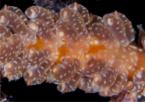
cerata detail

underside

side
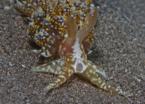
front
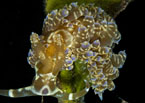
with blue

orange variant

faded
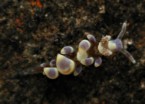
young, 3 mm
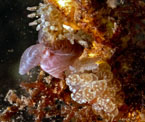
feeding
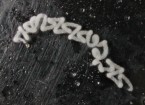
egg mass
_______________
GALLERY

Baeolidia moebii Bergh, 1888
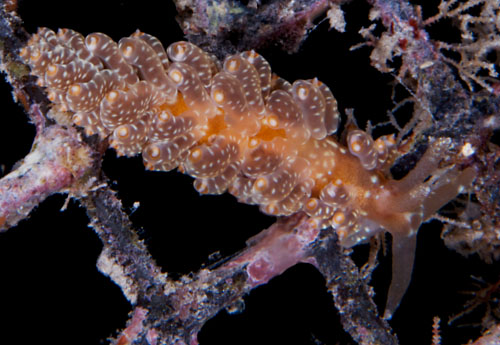
| Maximum size: 100 mm (Kay,
1979). Identification: This species has densely papillate rhinophores and extensive ramifications of the digestive gland in its notum, foot, rhinophores and cephalic tentacles. The cerata are moderately to greatly inflated (particularly in young animals) and they usually have iridescent-blue and/or orange subapical bands. Rarely, the cerata may have an orange sheen. The body and cerata are splotched with white. The ramifications of the digestive gland distinguish it from Baeolidia salaamica. Natural history: Baeolidia moebii is a moderately common species that appears to be largely restricted to Halimeda kanaloana beds at depths of 8-30 m (26-100 ft) (although it's been recorded from the low intertidal and shallow rocky habitats on Oahu by Scott Johnson and from 3 m (10 ft) in a Big Island marina by Paul Okumura). It is probably primarily diurnal and the extensive ramifications of its digestive gland suggest that it obtains significant nutrition from retained zooxanthellae. Gosliner (1973) reports it feeding on the sea anemones Boloceroides and Aiptasia while Rebecca Bicker and Jenna Szerlag photographed them feeding on a Stichodactyla sp. (Note 1) It lays a cream egg mass composed of a "slinky-like" ribbon. The eggs appear to hatch in about two days in the laboratory. Distribution: Big Island, Maui, Oahu and Kauai: widely distributed in the Indo-Pacific. Taxonomic notes: Some sites list this species as Spurilla major. It's listed as Berghia major in Kay, 1979, Gosliner, 1980, Bertsch & Johnson, 1981, Hoover, 1998 and Hoover, 2006. It's referred to as the "anemone-eating nudibranch" in Hoover, 1998 & 2006 although the photo is of Baeolidia salaamica (deleted in 5th printing). The photo of B. major in Bertsch and Johnson, 1981 is also of B. salaamica. It was first reported from Hawaii in Gosliner, 1980. The "orange variant" is a close match for the photo of this species in Gosliner, et. al. 2018. Photo: Paul Okumura: about 25 mm; Honokohau Marina, Kona, Big island; May 19, 2013. Observations and comments: Note 1: In Oct., 2010 a 9 mm animal was repeatedly offered juvenile and mature Bunodeopsis medusoides but showed no interest in that species (unlike Baeolidia scottjohnsoni). |
| Thumbnails |
Species
list |
Family | Next species | Top |